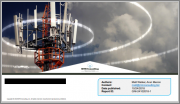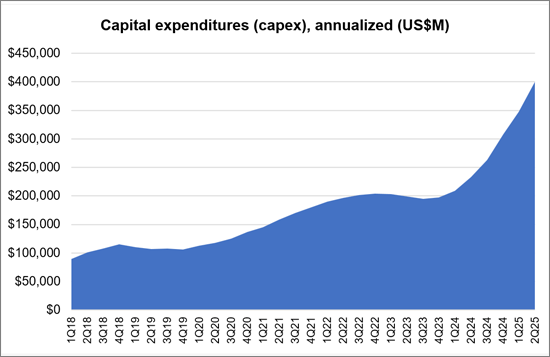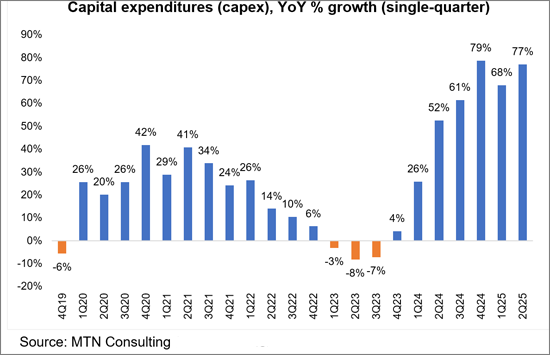
|
시장보고서
상품코드
1811146
웹 스케일 시장 추적 조사(2025년 2분기) : AI의 무분별한 투자로 12개월 자본 지출 4,000억 달러 돌파, 기술주 비중 사상 최고치 60% 기록Webscale Market Tracker, 2Q25: AIs Drunken Sailors Push 12-month Capex to $400B, Tech Share Hits All-time High of 60% |
||||||
NVIDIA는 다른 업체들이 경쟁하는 가운데 독주 : 데이터센터 연결 수요가 급증하는 상황에서 파이버&옵티컬 기업들은 이익을 얻을 수 있을 것입니다.
클라우드는 과거 웹스케일 급성장을 주도했지만, 이번에는 인공지능에 대한 투자자들의 열광이 주도하고 있습니다. 안타깝게도 최근 몇 분기 동안 이 급등세는 거품 영역에 완전히 진입했으며, 시장 붕괴에 따른 상당한 하락 위험이 존재합니다. 우리 의견으로는 폭락이 이미 예상보다 늦어지고 있습니다. 이 시장은 미친 수준의 과대광고에 시달리면서도 검증된 비즈니스 모델은 거의 없기 때문입니다. 인공지능 지출은 미국 정부의 보조금, 대중 시장의 소비자 관심(하지만 지불 의사는 거의 없음), 구매자와 판매자 간의 자기강화적 순환, 그리고 어떤 혜택이 있을지조차 모른 채 선점하려는 인공지능 과대광고 주체들의 열망이 결합되어 유지되어 왔습니다.
VISUALS


웹 스케일의 AI 기반 인프라 확장은 계속해서 기록을 갱신하고 있습니다. 2025년 2분기, 조사 대상 25개 기업의 매출은 7,220억 달러(전년 동기 대비 14.1% 증가)를 기록했습니다. 설비투자(CAPEX)는 1,220억 달러(+77.0%), 연구개발비(R&D)는 930억 달러(+17.8%)를 기록했습니다. 현금 보유액은 6,290억 달러(전년 동기 대비 보합), 부채는 5,670억 달러(+8.9%)를 기록했습니다. 유형자산(PP&E 순액)은 전년 대비 38.9% 증가한 1조 1,110억 달러로 급증했습니다. 직원수는 428만 명으로 전년 대비 1.2% 증가했습니다.
수익: 빅4에 집중된 성장
2025년 2분기 매출은 7,217억 달러(+14.1%)를 기록하고, 연간 환산 매출은 2조 8,200억 달러에 달할 전망입니다. 가장 높은 성장률을 보인 기업은 Nebius, CoreWeave, Yandex로, 첫 두 기업은 신생 기업이고, 세 번째 기업은 달러와 러시아 루블의 환율 변동에 영향을 받았습니다. 주요 업체들의 성장을 견인한 것은 Amazon(매출 전년 대비 +13.3%로 1,677억 달러), Alphabet(+13.8%로 964억 달러), Microsoft(+18.1%로 764억 달러), JD.com(+22.5%로 493억 달러), Meta(구 Facebook, +21.6%로 475억 달러) 등이었습니다.
설비투자(CAPEX) : AI 붐을 타고 지출 급증
2025년 2분기 설비투자는 전년 동기 대비 77.0% 증가한 1,215억 달러, 연간으로 환산하면 4,003억 달러에 달했습니다. 이는 1년 전보다 72% 증가하여 다시 한번 사상 최고치를 경신했습니다.
수익성: 설비 투자로 인한 수익률 압박
대규모 설비투자 지출의 영향으로 잉여현금흐름(FCF) 마진은 다시 하락하여 연간 환산 기준 13.3%를 기록했습니다. 이 13.3%라는 수치는 적어도 2011년 이후 두 번째로 낮은 수준이며, 2022년 4분기 연간 환산치 13.1%를 약간 상회하는 수준입니다. 단분기 기준 FCF 마진은 11.0%로 2022년 1분기와 함께 당사 데이터베이스 사상 최저치를 기록했습니다. 이 부문의 기업들은 지출에 있어 놀랍도록 무모한 태도를 보이고 있으며, 지금까지 투자자들은 "우려보다 신뢰"를 보이고 있지만, 닷컴 버블에 상처받은 회의적인 업계 분석가들뿐만 아니라 투자자들도 의구심을 품고 있습니다.
고용: 성장은 정체, 자동화의 그림자
웹스케일 기업 전체 직원 수는 428만 명으로 전년 대비 1.2% 증가했습니다. 최근 가장 큰 이슈가 된 것은 알리바바(Alibaba)다. 2025년 초 사업분할을 통해 직원 수가 크게 줄었습니다. 2025년 2분기 기준 직원 수는 12만 3,700명으로 전년 동기 대비 -38% 감소했습니다. 반면 JD.com은 인력을 확대하고 있으며, 2025년 2분기 말 기준 약 62만 5,000명으로 전년 동기 대비 15% 증가했습니다. Amazon, Meta, Alphabet은 모두 2025년 2분기 전년 동기 대비 완만한 성장세를 보였으나, Microsoft는 보합세를 보였습니다.
지역 동향 : 아시아의 회복
아시아태평양의 발목을 잡았던 족쇄가 풀리고 있습니다. 최근 몇 분기 동안 중국 시장의 침체가 아시아 전체의 세계 성장에 부담을 주었지만, 그 상황이 역전되었습니다. 2025년 2분기 전 세계 매출은 전년 동기 대비 14% 증가했으며, 4개 지역 모두 평균 성장률에 몇 퍼센트 이내의 성장률을 기록했습니다.
대상 기업
- 총 25개사 : 21개 기업이 활동 중이며 데이터를 공개하고 있고, 나머지 4개 기업은 활동 중단(ChinaCache), 비공개(Twitter), 또는 다른 기업의 일부(Altaba와 LinkedIn)를 공개하고 있습니다.
- 활동 중인 21개 업체 : Alibaba,Alphabet,Amazon,Apple,Baidu,Cognizant,CoreWeave,eBay,Fujitsu,HPE,IBM,JD.COM,Kuaishou,Meta(FB),Microsoft,Nebius,Oracle,SAP, Tencent,Xiaomi,Yandex. Tencent,Xiaomi,Yandex
- 2025년 2분기에 3개사 추가 : Kuaishou, Nebius, Xiaomi, CoreWeave는 2024년 4분기에 추가될 예정입니다.
본 보고서는 세계 주요 웹스케일 기업의 동향을 추적 조사하여 매출, 설비투자, 고용 등 각종 데이터를 정리한 보고서입니다.
목차
제1장 보고서 하이라이트
제2장 전망
제3장 분석
제4장 주요 통계
제5장 기업 상세 분석
제6장 기업 벤치마킹
제7장 지역별 분석
제8장 생 데이터
제9장 환율
제10장 당사에 대해
LSH 25.09.23NVIDIA is cleaning up while everyone else fights for scraps; fiber & optical specialists should cash in as data centers go connection-crazy
Cloud drove previous webscale surges, but investor excitement around artificial intelligence is driving this one. Unfortunately, this latest surge has been firmly in bubble territory for several quarters and there is significant downside risk for a crash. A crash is overdue, in our opinion, as this market is plagued by insane levels of hype but very little in the way of proven business models. AI spend has been propped up by a combination of US government subsidies, mass market consumer interest (but very little willingness to pay), a self-reinforcing loop between buyers and sellers, and AI hypemasters eager to be first - even if they have no idea what benefits this may deliver, if any.
VISUALS


Webscale's AI-driven infrastructure buildout keeps breaking records. In 2Q25, the 25 companies in our Webscale Tracker generated $722 billion (B) in revenue (+14.1% YoY), spent $122B on capex (+77.0%), poured $93B into R&D (+17.8%), and held $629B in cash (flat YoY) against $567B in debt (+8.9%). Net PP&E surged 38.9% YoY to $1.111 trillion. Headcount hit 4.28M (+1.2% YoY).
Notes: (1) This is MTN Consulting's 31st quarterly assessment of the webscale market, part of a series we launched in 4Q17; our data and analysis spans the 1Q11-2Q25 timeframe, i.e. 50 quarters. (2) The 25 companies in our study include several recent additions: CoreWeave (added last year), and this quarter's three new adds: Kuaishou, Nebius (Yandex spinoff), and Xiaomi.
Revenue: Growth Concentrated in the Big Four
2Q25 revenue hit $721.7B (+14.1% YoY), pushing annualized sales to $2.82 trillion (T). Nebius, CoreWeave and Yandex posted the fastest growth, but the first two are new companies and the third is impacted by recent USD-RUB exchange rate fluctuations. The heavy lifting came from Amazon (revenues up 13.3% YoY to $167.7B), Alphabet (+13.8% to $96.4B), Microsoft (+18.1% to $76.4B), JD.Com (+22.5% to $49.3B), and Meta (FB) (+21.6% to $47.5B).
Incidentally, JD.Com may be removed from our database at some point since it has deconsolidated its cloud unit and has no clear plans to reverse this decision. Its energy intensity is relatively high, like other webscalers, but it spends just over 1% of revenues on capex; the company is unlikely to challenge China's leading webscalers with established data center footprints (Alibaba, Tencent, Huawei).
At the other end, two companies saw revenues fall between 2Q24 and 2Q25: Fujitsu, down 2.6% YoY to $5.2B as it exited some European markets; and Baidu, down 3.5% YoY to $4.5B due to a significant drop in advertising revenue. Alibaba's revenues grew only 1.9% YoY to $34.2B, due to recent divestitures of Sun Art and Intime, which lowered Alibaba's revenue base.
Capex: AI Hype Sends Spending Soaring
Capex skyrocketed 77.0% YoY in 2Q25 to $121.5B, annualizing to $400.3B, up 72% from a year ago and setting another all-time high.
The AI frenzy, sparked by ChatGPT and fanned by investors, is now a dominant force. A review of the latest (2Q25) earnings calls from major US-based webscalers and other AI ecosystem players reveals a collective case of heads in the sand as AI infatuation continues. In none of these calls do tech leaders address when their AI investments will pay off. There are no signs of profitability from their early forays. Instead, there's just an emphasis on the need to go as fast as possible to establish an early lead in this race - a race they've defined, hoping it will lead to new riches. Riches for them and their shareholders, not for employees or users, of course. Most companies pass the buck when justifying their capital expenditure surge, claiming they are simply responding to unprecedented demand from clients. Yet those same clients are making the same risky bets, hoping that someone will eventually land on a sustainable business model for generative AI. Does the word "bubble" appear anywhere in any of the 2Q25 earnings calls from the key data center builders? Not from the webscalers. Zero. Nobody dares talk about the elephant in the room.
Top 2Q25 capex outlays came from Amazon ($32.2B), Alphabet ($22.4B), Microsoft ($17.1B), and Meta ($16.5B). Together, that is 73% of the global total.
Notably, 61% of annualized capex was for technical infrastructure (data center compute & networking, power & cooling, fiber & transport/routing gear, etc.) (vs. 55% in 2Q24), showing a focus on retrofitting existing data centers for AI. The 61% is an all-time high on an annualized basis.
Profitability: Margins Under Pressure from Capex
Free cash flow margins dipped again amidst massive capex outflows, down to 13.3% on an annualized basis. This 13.3% figure is the second lowest since at least 2011, just slightly higher than the 13.1% from 4Q22 annualized. The single quarter FCF margin of 11.0% was tied with 1Q22 as the lowest ever in our database. Companies in this sector have been surprisingly reckless in their spending, and investors so far are giving them the benefit of the doubt. But doubts are building, and not just with skeptical industry analysts scarred by the dotcom bubble's wreckage.
Net margins were relatively strong by comparison, averaging 20.8% in the 2Q25 annualized period - which is actually an all-time high since at least 2011. But net profits can be impacted by one-time items, tax windfalls, regulatory decisions, accounting charges or restatements, and other factors. FCF is a much stronger gauge of the market's overall health.
Meta (FB), Tencent, Microsoft and Apple top the FCF leaderboard, with annualized margins well above 20% through 2Q25. IBM, SAP and Alphabet each had around 18% results. The laggards were Oracle and Baidu, both slightly negative.
Debt vs. cash positions are still acceptable; the sector's $629.3B in cash still exceeds its $586.7B in total debt. But the gap (i.e. net debt) has been shrinking for several years. At its peak, the webscale market's cash exceeded debt by $292B in 4Q20, but that is now down to just $43B. That's not a disaster by itself as long as the debt can be financed at reasonable rates. Webscale's big US-based players are no doubt pushing the US president to keep interest rates down. In this way, they are contributing to Trump's lawless attempts to usurp the Fed's status as an independent monetary board. US-based webscale CEOs - Bezos, Zuckerberg, Sundar, Satya and Larry - are all openly engaged in politics and kissing up to the US government. While they justify it as a service to their shareholders, ultimately this distorts markets and may crash the global economy.
Employment: Flat Growth, Automation Looms
Webscale employment hit 4.28M, up 1.2% YoY. The big recent story is Alibaba, whose early 2025 spinoffs caused its headcount to drop dramatically. In 2Q25, its employee total was 123.7K, down 38% YoY. By contrast, JD.Com has been expanding headcount, ending 2Q25 with around 625K employees, up 15% YoY. Amazon, Meta, and Alphabet all grew modestly YoY in 2Q25, while Microsoft stayed flat.
There will be occasional modest swings up in webscale headcount, but automation and robotics are gaining ground, especially in logistics. We expect modest headcount gains in 2025, then a steady decline.
Regional Trends: Asia Rebounds
Asia-Pacific's drag is easing: for a few quarters, a weak Chinese market meant that Asia was a drag on global growth. That has reversed. Global revenues grew 14% YoY in 2Q25, and all four regions saw growth rates within a couple of percentage points of this average.
With strong government backing, Tencent and Alibaba are poised to accelerate Asia's momentum through 2026. Xiaomi also adds support for Asia's growth. It is having export market success with its devices and starting to invest in data centers and AI, with potential for much more to come.
Companies covered:
- 25 in total: 21 active and reporting data publicly, 4 either inactive (ChinaCache), gone private (Twitter), or now part of other companies (Altaba and LinkedIn).
- The 21 active companies include: Alibaba, Alphabet, Amazon, Apple, Baidu, Cognizant, CoreWeave, eBay, Fujitsu, HPE, IBM, JD.COM, Kuaishou, Meta (FB), Microsoft, Nebius, Oracle, SAP, Tencent, Xiaomi, and Yandex
- Three new companies have been added in 2Q25: Kuaishou, Nebius, and Xiaomi. CoreWeave was added in 4Q24.









